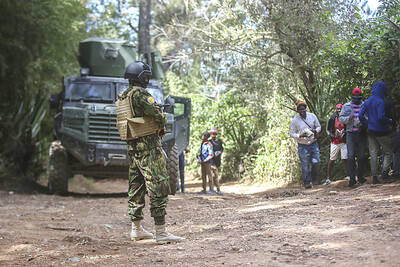Chinese authorities, seen as repressive toward Roman Catholics, are giving increasingly encouraging signals to the country's small Russian Orthodox community.
Orthodox followers in China hope they will soon be able to practice their faith normally after being forced into hibernation for many years, partly because of a lack of active priests.
The situation was due to be raised during Russian President Vladimir Putin's official visit to China last week, according to religious sources in Moscow, although this was not confirmed.
There are an estimated 10,000 to 12,000 Russian Orthodox Christians in China, either descendants of Russian immigrants or converted Chinese.
Most of them are in Inner Mongolia and around Urumqi, the capital of northwestern Xinjiang Province, although there are also a few hundred in Beijing, Shanghai, Tianjin and Harbin.
The Chinese Orthodox church reached its peak in the mid-1950s when it became autonomous and had two bishops who oversaw an estimated 20,000 faithful. However, the church was to suffer much at the hands of the Red Guard, which drove it underground in 1966.
The two bishops died in the 1960s and have never had any successors.
China's Orthodox community has since diminished, with many expecting it to disappear altogether after the death of the last active priest in December.
But, benefiting from the current healthy political climate between Moscow and Beijing, the Russian patriarchate has taken steps to revive the faith in the country.
The most important of these was the decision by Beijing to allow 18 Chinese students to undertake studies in seminaries of Moscow and Saint Petersburg.
"If they are allowed to fulfil their priesthoods in China by the Administration for Religious Affairs, one day they will become bishops and be able to ordain priests. Orthodoxy will thus return in China," said Russian businessman Dmitry Napara, who is delighted with the move.
Last June, China permitted an Orthodox monk from Alapayevsk, in Russia's Ural Mountains, to celebrate mass in northeastern Harbin, which is probably China's most Russian-influenced city.
The church has remained open in Harbin, where the faithful have had to make do with services held by laymen since the death of their priest more than four years ago.
In another gesture from Beijing, two Orthodox churches in Shanghai, one of which had been converted into a nightclub, will be returned to "more serious" use, according to Napara.
It was likely that one of them would be developed into an arts centre devoted to the history of the Russian presence in China, he says.
Napara also said the pragmatic Chinese may see the activities of the church in Harbin as an opportunity to attract tourists.

DITCH TACTICS: Kenyan officers were on their way to rescue Haitian police stuck in a ditch suspected to have been deliberately dug by Haitian gang members A Kenyan policeman deployed in Haiti has gone missing after violent gangs attacked a group of officers on a rescue mission, a UN-backed multinational security mission said in a statement yesterday. The Kenyan officers on Tuesday were on their way to rescue Haitian police stuck in a ditch “suspected to have been deliberately dug by gangs,” the statement said, adding that “specialized teams have been deployed” to search for the missing officer. Local media outlets in Haiti reported that the officer had been killed and videos of a lifeless man clothed in Kenyan uniform were shared on social media. Gang violence has left

US Vice President J.D. Vance on Friday accused Denmark of not having done enough to protect Greenland, when he visited the strategically placed and resource-rich Danish territory coveted by US President Donald Trump. Vance made his comment during a trip to the Pituffik Space Base in northwestern Greenland, a visit viewed by Copenhagen and Nuuk as a provocation. “Our message to Denmark is very simple: You have not done a good job by the people of Greenland,” Vance told a news conference. “You have under-invested in the people of Greenland, and you have under-invested in the security architecture of this

A fire caused by a burst gas pipe yesterday spread to several homes and sent a fireball soaring into the sky outside Malaysia’s largest city, injuring more than 100 people. The towering inferno near a gas station in Putra Heights outside Kuala Lumpur was visible for kilometers and lasted for several hours. It happened during a public holiday as Muslims, who are the majority in Malaysia, celebrate the second day of Eid al-Fitr. National oil company Petronas said the fire started at one of its gas pipelines at 8:10am and the affected pipeline was later isolated. Disaster management officials said shutting the

Japan unveiled a plan on Thursday to evacuate around 120,000 residents and tourists from its southern islets near Taiwan within six days in the event of an “emergency”. The plan was put together as “the security situation surrounding our nation grows severe” and with an “emergency” in mind, the government’s crisis management office said. Exactly what that emergency might be was left unspecified in the plan but it envisages the evacuation of around 120,000 people in five Japanese islets close to Taiwan. China claims Taiwan as part of its territory and has stepped up military pressure in recent years, including